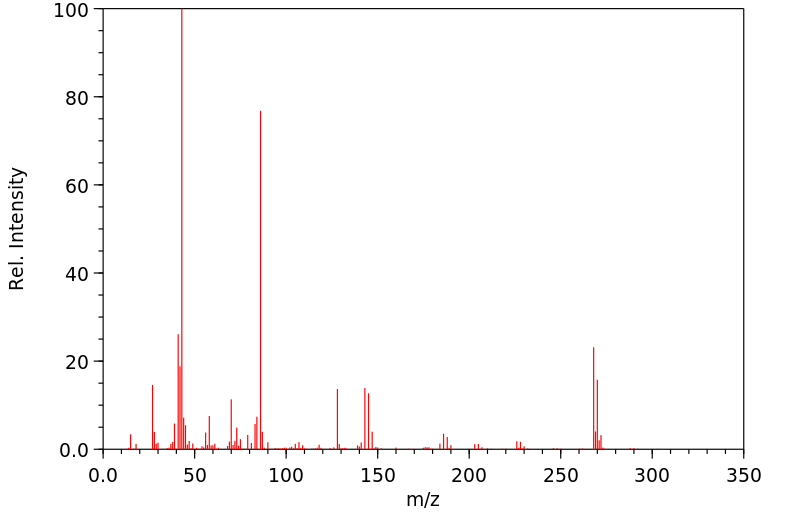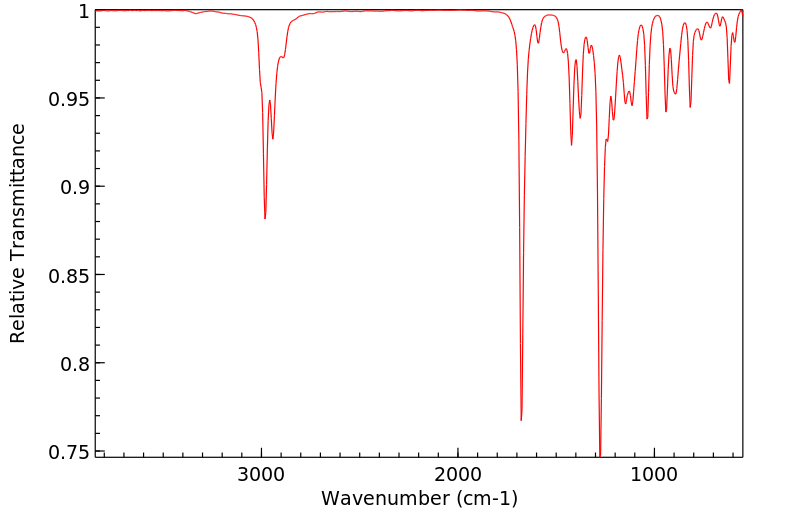野麦畏 | 2303-17-5
-
物化性质
-
计算性质
-
ADMET
-
安全信息
-
SDS
-
制备方法与用途
-
上下游信息
-
文献信息
-
表征谱图
-
同类化合物
-
相关功能分类
-
相关结构分类
物化性质
-
熔点:29-30°C
-
沸点:117°C (0.3 mmHg)
-
密度:1.273
-
闪点:2 °C
-
溶解度:氯仿(少量溶解)、DMSO(少量溶解)、乙酸乙酯(少量溶解)、甲醇(少量溶解)
-
LogP:4.600
-
物理描述:Triallate, [solid] appears as colorless crystals or oily amber liquid. Toxic by inhalation, ingestion or skin absorption. Used as a pesticide.
-
颜色/状态:Dark brown to yellow solid; (>30 °C clear brown to dark brown liquid)
-
蒸汽密度:Relative vapor density (air = 1): 10.5
-
蒸汽压力:1.2X10-4 mm Hg at 25 °C (16 mPa)
-
稳定性/保质期:
对兔眼睛有轻度刺激作用,对皮肤有中等刺激性。在动物体内可能会有一定蓄积作用。
-
分解:Hazardous decomposition products formed under fire conditions - Carbon oxides, nitrogen oxides (NOx), sulfur oxides, hydrogen chloride gas.
-
腐蚀性:Corrosive to many metals ...
-
保留指数:1809;1823;1832;1808.6;1804.4;1828.5
计算性质
-
辛醇/水分配系数(LogP):4.4
-
重原子数:16
-
可旋转键数:5
-
环数:0.0
-
sp3杂化的碳原子比例:0.7
-
拓扑面积:45.6
-
氢给体数:0
-
氢受体数:2
ADMET
安全信息
-
危险品标志:Xn,N
-
安全说明:S16,S24,S26,S36,S37,S60,S61
-
危险类别码:R22,R48/22,R50/53,R43
-
WGK Germany:3
-
海关编码:2930200013
-
危险品运输编号:UN 3077
-
RTECS号:EZ8575000
-
包装等级:I; II; III
-
危险类别:6.1
-
储存条件:库房应保持通风、低温和干燥,并与食品原料分开储存和运输。
SDS
| 第一部分:化学品名称 |
| 化学品中文名称: | 野麦畏;阿畏达 |
| 化学品英文名称: | Triallate;Diisopropyltrichloroallylthiocarbamate |
| 中文俗名或商品名: | |
| Synonyms: | |
| CAS No.: | 2303-17-5 |
| 分子式: | C 10 H 16 Cl 3 NOS |
| 分子量: | 304.68 |
| 第二部分:成分/组成信息 |
| 纯化学品 混合物 | |||
| 化学品名称:野麦畏;阿畏达 | |||
|
| 第三部分:危险性概述 |
| 危险性类别: | 第6.1类 毒害品 |
| 侵入途径: | 吸入 食入 经皮吸收 |
| 健康危害: | 本品为低毒除草剂。对眼睛、皮肤、粘膜有刺激作用。 |
| 环境危害: | |
| 燃爆危险: | 本品可燃,具刺激性。 |
| 第四部分:急救措施 |
| 皮肤接触: | 用肥皂水及清水彻底冲洗。就医。 |
| 眼睛接触: | 拉开眼睑,用流动清水冲洗15分钟。就医。 |
| 吸入: | 脱离现场至空气新鲜处。就医。 |
| 食入: | 误服者,饮适量温水,催吐。就医。 |
| 第五部分:消防措施 |
| 危险特性: | 遇明火、高热可燃。受高热分解,放出有毒的烟气。 |
| 有害燃烧产物: | 一氧化碳、二氧化碳、氮氧化物、氧化硫、氯化氢。 |
| 灭火方法及灭火剂: | 消防人员须佩戴防毒面具、穿全身消防服,在上风向灭火。尽可能将容器从火场移至空旷处。喷水保持火场容器冷却,直至灭火结束。处在火场中的容器若已变色或从安全泄压装置中产生声音,必须马上撤离。灭火剂:泡沫、干粉、砂土。 |
| 消防员的个体防护: | |
| 禁止使用的灭火剂: | |
| 闪点(℃): | |
| 自燃温度(℃): | |
| 爆炸下限[%(V/V)]: | |
| 爆炸上限[%(V/V)]: | |
| 最小点火能(mJ): | |
| 爆燃点: | |
| 爆速: | |
| 最大燃爆压力(MPa): | |
| 建规火险分级: |
| 第六部分:泄漏应急处理 |
| 应急处理: | 疏散泄漏污染区人员至安全区,禁止无关人员进入污染区,建议应急处理人员戴好防毒面具,穿化学防护服。用砂土吸收,铲入提桶,运至废物处理场所。在污染区撒上石灰,用大量水冲洗,经稀释的污水放入废水系统。如大量泄漏,利用围堤收容,然后收集、转移、回收或无害处理后废弃。 |
| 第七部分:操作处置与储存 |
| 操作注意事项: | 密闭操作,局部排风。防止蒸气泄漏到工作场所空气中。操作人员必须经过专门培训,严格遵守操作规程。建议操作人员佩戴自吸过滤式防毒面具(半面罩),戴化学安全防护眼镜,穿防毒物渗透工作服,戴橡胶手套。远离火种、热源,工作场所严禁吸烟。使用防爆型的通风系统和设备。在清除液体和蒸气前不能进行焊接、切割等作业。避免产生烟雾。避免与氧化剂接触。配备相应品种和数量的消防器材及泄漏应急处理设备。倒空的容器可能残留有害物。 |
| 储存注意事项: | 储存于阴凉、通风的库房。远离火种、热源。防止阳光直射。寒冷季节要注意保持库温在结晶点以上,防止冻裂容器及变质。保持容器密封。应与氧化剂分开存放,切忌混储。配备相应品种和数量的消防器材。储区应备有泄漏应急处理设备和合适的收容材料。 |
| 第八部分:接触控制/个体防护 |
| 最高容许浓度: | 中 国 MAC:未制订标准前苏联 MAC:未制订标准美国TLV—TWA:未制订标准 |
| 监测方法: | |
| 工程控制: | 密闭操作,局部排风。 |
| 呼吸系统防护: | 生产操作或农业使用时,佩戴防毒口罩。紧急事态抢救或逃生时,应该佩戴防毒面具。 |
| 眼睛防护: | 必要时可采用安全面罩。 |
| 身体防护: | 穿工作服。 |
| 手防护: | 戴防护手套。 |
| 其他防护: | 工作现场禁止吸烟、进食和饮水。工作后,淋浴更衣。注意个人清洁卫生。 |
| 第九部分:理化特性 |
| 外观与性状: | 琥珀色油状液体。 |
| pH: | |
| 熔点(℃): | 29~30 |
| 沸点(℃): | 136/0.133kPa |
| 相对密度(水=1): | 1.273(25/15.6℃) |
| 相对蒸气密度(空气=1): | |
| 饱和蒸气压(kPa): | 0.16*(10-4)/25℃ |
| 燃烧热(kJ/mol): | |
| 临界温度(℃): | |
| 临界压力(MPa): | |
| 辛醇/水分配系数的对数值: | |
| 闪点(℃): | |
| 引燃温度(℃): | |
| 爆炸上限%(V/V): | |
| 爆炸下限%(V/V): | |
| 分子式: | C 10 H 16 Cl 3 NOS |
| 分子量: | 304.68 |
| 蒸发速率: | |
| 粘性: | |
| 溶解性: | 微溶于水,溶于乙醚、丙酮、苯。 |
| 主要用途: | 用作农用除草剂。 |
| 第十部分:稳定性和反应活性 |
| 稳定性: | 在常温常压下 稳定 |
| 禁配物: | 强氧化剂。 |
| 避免接触的条件: | |
| 聚合危害: | 不能出现 |
| 分解产物: | 一氧化碳、二氧化碳、氮氧化物、氯化氢、氧化硫。 |
| 第十一部分:毒理学资料 |
| 急性毒性: | 属低毒类 LD50:1675~2165mg/kg(大鼠经口);2225~4050mg/kg(兔经皮) LC50:5300mg/m3(大鼠吸入) |
| 急性中毒: | |
| 慢性中毒: | |
| 亚急性和慢性毒性: | |
| 刺激性: | |
| 致敏性: | |
| 致突变性: | |
| 致畸性: | |
| 致癌性: |
| 第十二部分:生态学资料 |
| 生态毒理毒性: | |
| 生物降解性: | |
| 非生物降解性: | |
| 生物富集或生物积累性: |
| 第十三部分:废弃处置 |
| 废弃物性质: | |
| 废弃处置方法: | 塑料容器要彻底冲洗,不能重复使用。把倒空的容器归还厂商或在规定场所掩埋。 |
| 废弃注意事项: |
| 第十四部分:运输信息 |
| |
| 危险货物编号: | 61889 |
| UN编号: | 2992 |
| 包装标志: | |
| 包装类别: | |
| 包装方法: | 塑料袋或二层牛皮纸袋外全开口或中开口钢桶;两层塑料袋或一层塑料袋外麻袋、塑料编织袋、乳胶布袋;塑料袋外复合塑料编织袋(聚丙烯三合一袋、聚乙烯三合一袋、聚丙烯二合一袋、聚乙烯二合一袋);塑料袋或二层牛皮纸袋外普通木箱;螺纹口玻璃瓶、塑料瓶、复合塑料瓶或铝瓶外普通木箱;塑料瓶、两层塑料袋或两层牛皮纸袋(内或外套以塑料袋)外瓦楞纸箱。 |
| 运输注意事项: | 储存于阴凉、通风仓间内。远离火种、热源。专人保管。保持容器密封。注意防潮和雨淋。防止阳光曝晒。寒冷季节要注意保持库温在结晶点以上,防止冻裂容器及变质。不能与粮食、食物、种子、饲料、各种日用品混装、混运 |
| RETCS号: | |
| IMDG规则页码: |
| 第十五部分:法规信息 |
| 国内化学品安全管理法规: | 化学危险物品安全管理条例 (1987年2月17日国务院发布),化学危险物品安全管理条例实施细则 (化劳发[1992] 677号),工作场所安全使用化学品规定 ([1996]劳部发423号)等法规,针对化学危险品的安全使用、生产、储存、运输、装卸等方面均作了相应规定;常用危险化学品的分类及标志 (GB 13690-92)将该物质划为第6.1 类毒害品。 |
| 国际化学品安全管理法规: |
| 第十六部分:其他信息 |
| 参考文献: | 1.周国泰,化学危险品安全技术全书,化学工业出版社,1997 2.国家环保局有毒化学品管理办公室、北京化工研究院合编,化学品毒性法规环境数据手册,中国环境科学出版社.1992 3.Canadian Centre for Occupational Health and Safety,CHEMINFO Database.1998 4.Canadian Centre for Occupational Health and Safety, RTECS Database, 1989 |
| 填表时间: | 年月日 |
| 填表部门: | |
| 数据审核单位: | |
| 修改说明: | |
| 其他信息: | 6 |
| MSDS修改日期: | 年月日 |
制备方法与用途
毒性 大鼠急性经口LD₅₀为1675~2165 mg/kg(平均约1800 mg/kg),家兔急性经皮LD₅₀为2225~4050 mg/kg。大鼠喂养2年无作用剂量为200 mg/kg。对兔眼睛有轻度刺激,对皮肤有中等刺激性。在动物体内蓄积作用中等。Ames试验结果为阴性。国外报道该物质在Ames试验(TA₁₅₃₅、TA₉₈、TA₁₀₀)中有轻度诱变作用,高剂量组(1/5 LD₅₀)可导致小鼠骨髓细胞微核率增高。在实验条件下对大鼠和家兔无致畸或致癌作用。虹鳟鱼LC₅₀为1.2 mg/L (96h),鹌鹑急性经口LD₅₀为2251 mg/kg。
化学性质 本品为琥珀色油状液体,熔点29~30℃,沸点约148~149℃/1.199×10³ Pa,蒸气压15.99×10⁻³ Pa (25℃),相对密度1.273(25℃)。能溶于丙酮、乙醇、苯、甲苯等多种有机溶剂,水中溶解度为4 mg/L。对光稳定,无腐蚀性。
用途 野麦畏是一种选择性的土壤处理剂,适用于防除野燕麦,尤其在大麦和小麦田中效果显著。它通过杂草芽鞘或第一片子叶吸收药剂后,影响细胞的蛋白质合成和有丝分裂,抑制细胞伸长,使杂草未出土即死亡。可用于多种作物如油菜、豌豆、亚麻、甜菜、青梨和大豆等,建议用量为8~16 g有效成分/100 m²,并与土壤充分混合施用。
生产方法 将二异丙胺加入氢氧化钠溶液中,搅拌冷却至0-5℃,通入二硫化碳直至完成计算量。随后加入1,1',2,3-四氯丙烯,在0-65℃反应6小时后冷却静置分层。上层为母液,下层粗产品减压蒸馏除去低沸物后得到野麦畏。原料消耗定额:二异丙胺(96%)300 kg/t、四氯丙烯(80%)600 kg/t、氯气600 kg/t。
另一种生产方法如下:将3 g氢氧化钠溶于20 mL水中,与5.5 g (98%)二异丙胺混合后冷却至0~5℃。在搅拌下通入氧硫化碳气体约3 g左右,产生大量结晶,保温反应后继续投入18 g (70%) 1,1',2,3-四氯丙烯,在0~65℃条件下反应6小时。冷却静置分层,将下层粗产品减压蒸馏除去低沸物后得到琥珀色黏稠状液体即为野麦畏。
类别 农药
毒性分级 中毒
急性毒性 口服 - 大鼠 LD₅₀: 800 毫克/公斤;小鼠 LD₅₀: 930 毫克/公斤
可燃性危险特性 燃烧时产生有毒氮氧化物、氯化物和硫氧化物气体
储运特性 库房需通风低温干燥,与食品原料分开储存运输
灭火剂 干粉、泡沫、砂土
上下游信息
-
下游产品
中文名称 英文名称 CAS号 化学式 分子量 —— Triallate sulfoxide 71133-38-5 C10H16Cl3NO2S 320.668
反应信息
-
作为反应物:参考文献:名称:高效液相色谱法对农药进行柱后光解,用于荧光测定。摘要:DOI:10.1021/ac00154a007
-
作为产物:参考文献:名称:DENISOV, E. N.;KALININA, O. G., SOZDANIE PERSPEKT. PESTITSIDOV I SYRYA DLYA IX PR-BA, UFA,(1989) S. 8摘要:DOI:
文献信息
-
[EN] ACC INHIBITORS AND USES THEREOF<br/>[FR] INHIBITEURS DE L'ACC ET UTILISATIONS ASSOCIÉES
-
[EN] 3-[(HYDRAZONO)METHYL]-N-(TETRAZOL-5-YL)-BENZAMIDE AND 3-[(HYDRAZONO)METHYL]-N-(1,3,4-OXADIAZOL-2-YL)-BENZAMIDE DERIVATIVES AS HERBICIDES<br/>[FR] DÉRIVÉS DE 3-[(HYDRAZONO))MÉTHYL]-N-(TÉTRAZOL-5-YL)-BENZAMIDE ET DE 3-[(HYDRAZONO)MÉTHYL]-N-(1,3,4-OXADIAZOL-2-YL)-BENZAMIDE UTILISÉS EN TANT QU'HERBICIDES申请人:SYNGENTA CROP PROTECTION AG公开号:WO2021013969A1公开(公告)日:2021-01-28The present invention related to compounds of Formula (I): or an agronomically acceptable salt thereof, wherein Q, R2, R3, R4, R5 and R6 are as described herein. The invention further relates to compositions comprising said compounds, to methods of controlling weeds using said compositions, and to the use of compounds of Formula (I) as a herbicide.本发明涉及以下式(I)的化合物或其农业上可接受的盐,其中Q、R2、R3、R4、R5和R6如本文所述。该发明还涉及包含所述化合物的组合物,使用这些组合物控制杂草的方法,以及将式(I)的化合物用作除草剂的用途。
-
[EN] INSECTICIDAL TRIAZINONE DERIVATIVES<br/>[FR] DÉRIVÉS DE TRIAZINONE INSECTICIDES申请人:SYNGENTA PARTICIPATIONS AG公开号:WO2013079350A1公开(公告)日:2013-06-06Compounds of the formula (I) or (I'), wherein the substituents are as defined in claim 1, are useful as pesticides.式(I)或(I')的化合物,其中取代基如权利要求1所定义的那样,可用作杀虫剂。
-
[EN] HERBICIDALLY ACTIVE HETEROARYL-S?BSTIT?TED CYCLIC DIONES OR DERIVATIVES THEREOF<br/>[FR] DIONES CYCLIQUES SUBSTITUÉES PAR HÉTÉROARYLE À ACTIVITÉ HERBICIDE OU DÉRIVÉS DE CELLES-CI申请人:SYNGENTA LTD公开号:WO2011012862A1公开(公告)日:2011-02-03The invention relates to a compound of formula (I), which is suitable for use as a herbicide wherein G is hydrogen or an agriculturally acceptable metal, sulfonium, ammonium or latentiating group; Q is a unsubstituted or substituted C3-C8 saturated or mono-unsaturated heterocyclyl containing at least one heteroatom selected from O, N and S, or Q is heteroaryl or substituted heteroaryl; m is 1, 2 or 3; and Het is an optionally substituted monocyclic or bicyclic heteroaromatic ring; and wherein the compound is optionally an agronomically acceptable salt thereof.
-
Molecules having pesticidal utility, and intermediates, compositions, and processes, related thereto申请人:Dow AgroSciences LLC公开号:US20180279612A1公开(公告)日:2018-10-04This disclosure relates to the field of molecules having pesticidal utility against pests in Phyla Arthropoda, Mollusca, and Nematoda, processes to produce such molecules, intermediates used in such processes, pesticidal compositions containing such molecules, and processes of using such pesticidal compositions against such pests. These pesticidal compositions may be used, for example, as acaricides, insecticides, miticides, molluscicides, and nematicides. This document discloses molecules having the following formula (“Formula One”).
表征谱图
-
氢谱1HNMR
-
质谱MS
-
碳谱13CNMR
-
红外IR
-
拉曼Raman
-
峰位数据
-
峰位匹配
-
表征信息








